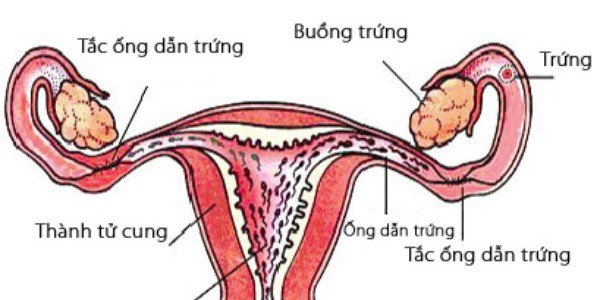Infertility due to blockage and fluid retention of fallopian tubes
The article is professionally consulted by MSc, BS. Nguyen Thi Tam Ly, Reproductive Support Center, Vinmec Times City International General Hospital.
Fallopian tube blockage, tubal fluid retention can be caused by many different reasons. This condition can be one of the causes of infertility in women today. So what is blocked fallopian tubes due to fluid retention?
1. What is tubal stasis?
The fallopian tube is the place where the egg is received after ovulation, where the sperm and egg meet and fertilize to form an embryo. Fallopian tube blockage is a disease that interferes with this process.
Fallopian tube blockage can be caused by many different causes such as: Infection, fallopian tube malformation or endometriosis. One of the other common causes is tubal fluid retention, which, if prolonged, can lead to infertility.
Tubal fluid retention occurs due to the accumulation of sterile fluid in the fallopian tubes. Most of the cases of detecting tubal fluid retention when the patient comes to the infertility clinic and is checked by modern means such as: hysteroscopy, contrast-enhanced fallopian tubes or ultrasound. A small number of patients come to the hospital for examination because of adnexal abscess.
Fallopian tube blockage can be caused by many different causes such as: Infection, fallopian tube malformation or endometriosis. One of the other common causes is tubal fluid retention, which, if prolonged, can lead to infertility.
Tubal fluid retention occurs due to the accumulation of sterile fluid in the fallopian tubes. Most of the cases of detecting tubal fluid retention when the patient comes to the infertility clinic and is checked by modern means such as: hysteroscopy, contrast-enhanced fallopian tubes or ultrasound. A small number of patients come to the hospital for examination because of adnexal abscess.
2. Causes of blocked fallopian tubes due to fluid retention
Tubal stasis or tubal stasis can be the result of some of the following causes:
Gynecological diseases such as vaginal or fallopian tube infections, pelvic inflammatory disease; Endometrial optimism; Sexually transmitted diseases are not thoroughly treated; Having unprotected sex; Poor hygiene of the intimate area, especially after sex or menstruation; Fluid retention after tubal surgery, pelvic inflammatory disease, or intra-abdominal surgery such as ruptured appendicitis, Inflammatory processes or injury to the genital area involving the fallopian tubes will stimulate the body's immune system. and trigger an inflammatory response in the affected area. This process can inadvertently damage the fallopian tubes, secrete fluid, and block the fallopian tubes.
Gynecological diseases such as vaginal or fallopian tube infections, pelvic inflammatory disease; Endometrial optimism; Sexually transmitted diseases are not thoroughly treated; Having unprotected sex; Poor hygiene of the intimate area, especially after sex or menstruation; Fluid retention after tubal surgery, pelvic inflammatory disease, or intra-abdominal surgery such as ruptured appendicitis, Inflammatory processes or injury to the genital area involving the fallopian tubes will stimulate the body's immune system. and trigger an inflammatory response in the affected area. This process can inadvertently damage the fallopian tubes, secrete fluid, and block the fallopian tubes.

Tắc ống dẫn trứng có thể do nhiều nguyên nhân khác nhau gây ra
3. Manifestations of tubal fluid retention
Manifestations of blocked fallopian tubes due to fluid retention are difficult to detect, easily confused with other gynecological diseases, making women subjective and hesitant not to go to a specialized medical facility for diagnosis and treatment. timely treatment. Some manifestations of tubal fluid retention may be encountered:
Dull lower abdominal pain, especially more painful when approaching the menstrual cycle; Irregular menstrual cycle, lasting for many days or irregular menstrual bleeding; Infertile infertility despite regular sex and no diseases related to the uterus and ovaries; Vaginal discharge a lot, sex feels painful... Fallopian tube retention if not treated and treated can lead to infertility due to:
Fallopian tube blockage interrupts the fertilization process between egg and sperm. Prolonged fluid retention causes the fallopian tube to completely block, causing infection and even requiring removal of the fallopian tube.
Dull lower abdominal pain, especially more painful when approaching the menstrual cycle; Irregular menstrual cycle, lasting for many days or irregular menstrual bleeding; Infertile infertility despite regular sex and no diseases related to the uterus and ovaries; Vaginal discharge a lot, sex feels painful... Fallopian tube retention if not treated and treated can lead to infertility due to:
Fallopian tube blockage interrupts the fertilization process between egg and sperm. Prolonged fluid retention causes the fallopian tube to completely block, causing infection and even requiring removal of the fallopian tube.

Các biểu hiện của tắc ống dẫn trứng do ứ dịch rất khó phát hiện
4. Diagnostic tests for tubal fluid retention
Conventional abdominal ultrasound: This method can detect tubal fluid retention but is less effective than transvaginal ultrasound; Hysterosalpingogram (HSG): This imaging method is very valuable for detecting tubal occlusion. The doctor conducts contrast injection before taking X-rays to detect abnormalities of the reproductive organs; Laparoscopy: Direct observation with the naked eye to record the blockage of the fallopian tubes due to fluid retention or other causes. See also: The possibility of pregnancy when blocked fallopian tubes
5. Treatment of tubal fluid retention
5.1 Laparoscopic tubal reconstruction Laparoscopic tubal reconstruction is an interventional technique to help recanalize the site of fluid blockage, thereby increasing the chances of sperm reaching an egg, increasing the rate of fertilization. successful crystal.
This surgery will be performed after the doctor evaluates various factors such as the condition of the hospital facilities, the patient's age and desire to have children and most importantly the severity of the condition tubal effusion.
Some disadvantages of this method are the possibility of recurrence of fallopian tube blockage and the need for re-surgery, at the same time the risk of ectopic pregnancy will increase
The possibility of tubal fluid retention will recur quickly within 3-6 months after laparoscopy, so patients need to support other pregnancy methods instead of waiting for natural conception such as ovarian stimulation and sperm injection into the uterus.
This surgery will be performed after the doctor evaluates various factors such as the condition of the hospital facilities, the patient's age and desire to have children and most importantly the severity of the condition tubal effusion.
Some disadvantages of this method are the possibility of recurrence of fallopian tube blockage and the need for re-surgery, at the same time the risk of ectopic pregnancy will increase
The possibility of tubal fluid retention will recur quickly within 3-6 months after laparoscopy, so patients need to support other pregnancy methods instead of waiting for natural conception such as ovarian stimulation and sperm injection into the uterus.

Phương pháp nội soi tái tạo vòi trứng là kỹ thuật can thiệp giúp tái thông tại vị trí bị tắc nghẽn do dịch
5.2 Laparoscopic colectomy This is the treatment of choice in cases of severe or recurrent tubal fluid retention. The choice of surgical method depends on whether the patient has an adnexal abscess or not. If not, simply clamp close to the corner of the blocked fallopian tube. In contrast, in patients with a history of adnexal abscess, tubal ablation should be performed to limit recurrence.
Even if the fallopian tube is blocked due to sterile fluid, the possibility of recurrent infection of the fallopian tube can still occur and lead to pus-filled fallopian tube, adnexal abscess.
If only one fallopian tube is damaged, after laparoscopic clipping, the patient can still get pregnant naturally or through some active support measures. In patients with indications for in vitro fertilization, tubal ligation with fluid retention should still be used to reduce the risk of recurrent infection and increase the likelihood of pregnancy and delivery.
Currently, customers can come to the Fertility Center - Vinmec International General Hospital. This is the leading center in Vietnam, which has developed and applied a comprehensive medical examination and treatment process, combining both gynecology and obstetrics and gynecology to provide the optimal method for each patient's case.
Advantages when customers choose Vinmec fertility center:
Equipped with modern equipment, clean air system according to international standards to ensure lab quality, single cabinet system to optimize quality embryo, improving the success rate for each cycle of artificial insemination. Implement most advanced assisted reproductive techniques in the world: ICSI (injection of sperm into the oocyte cytoplasm); support embryo escape membrane; Reproductive reserve: embryo freezing, sperm freezing, oocyte freezing to help customers take the initiative in giving birth at will, transferring embryos on day 5, minimizing pregnancy; male infertility techniques (PESA, MESA, TEFNA, TESE) Besides advanced reproductive support methods, a team of excellent doctors in the country and the world, with prestige and long-term experience in the field of infertility .
Even if the fallopian tube is blocked due to sterile fluid, the possibility of recurrent infection of the fallopian tube can still occur and lead to pus-filled fallopian tube, adnexal abscess.
If only one fallopian tube is damaged, after laparoscopic clipping, the patient can still get pregnant naturally or through some active support measures. In patients with indications for in vitro fertilization, tubal ligation with fluid retention should still be used to reduce the risk of recurrent infection and increase the likelihood of pregnancy and delivery.
Currently, customers can come to the Fertility Center - Vinmec International General Hospital. This is the leading center in Vietnam, which has developed and applied a comprehensive medical examination and treatment process, combining both gynecology and obstetrics and gynecology to provide the optimal method for each patient's case.
Advantages when customers choose Vinmec fertility center:
Equipped with modern equipment, clean air system according to international standards to ensure lab quality, single cabinet system to optimize quality embryo, improving the success rate for each cycle of artificial insemination. Implement most advanced assisted reproductive techniques in the world: ICSI (injection of sperm into the oocyte cytoplasm); support embryo escape membrane; Reproductive reserve: embryo freezing, sperm freezing, oocyte freezing to help customers take the initiative in giving birth at will, transferring embryos on day 5, minimizing pregnancy; male infertility techniques (PESA, MESA, TEFNA, TESE) Besides advanced reproductive support methods, a team of excellent doctors in the country and the world, with prestige and long-term experience in the field of infertility .
Để đặt lịch khám tại viện, Quý khách vui lòng bấm số HOTLINE hoặc đặt lịch trực tiếp TẠI ĐÂY. Tải và đặt lịch khám tự động trên ứng dụng MyVinmec để quản lý, theo dõi lịch và đặt hẹn mọi lúc mọi nơi ngay trên ứng dụng.
Bài viết này được viết cho người đọc tại Sài Gòn, Hà Nội, Hồ Chí Minh, Phú Quốc, Nha Trang, Hạ Long, Hải Phòng, Đà Nẵng.






